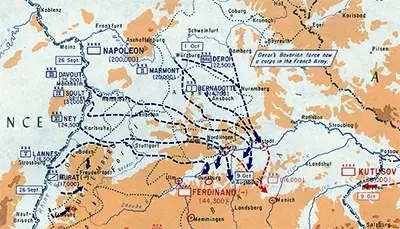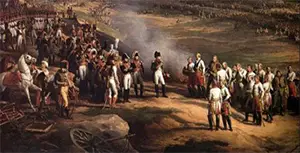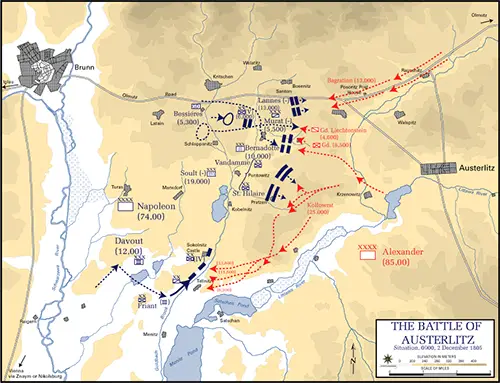The Battle of Austerlitz
The Battle of Austerlitz was a landmark victory for France during the War of the Third Coalition. The French victory forced Austria out of the war and resulted in the end of the Holy Roman Empire. 
By the summer of 1805, French armies had abandoned any pretense of invading the United Kingdom and had focused on confronting other enemies in Europe. In August, the Grand Armée vaulted eastward, crossing the Rhine in large numbers and aiming to confront Austrian forces massing in and around Vienna. Feldmarschall-Leutnant Karl Mack of Austria had a plan to concentrate forces near Augsburg, on the Lech River. After a large amount of his troops had occupied Munich, Mack changed the plan. This had a cascading effect of miscommunication that was worsened by increasingly bad weather. France had achieved the advantage of surprise in part, crossing the Danube as well, and also had twice as many troops, and this led to a quick victory at Wertingen. Austrian forces were too slow to react and, consequently, unable to organize a proper retreat. The October 8 battle ended with almost the entire Austrian force of 5,000 lost. Marshals Joachim Murat and Jean Lannes had scored a quick initial victory. That victory at Wertingen was due in part to Mack's decision to send only a small force to confront Murat and Lannes. The very next day, another battle, at Günzburg, resulted in nearly as many Austrian casualties, with French losses only one third as high. A further engagement two days later at Haslach-Jungingen was inconclusive in terms of victory or defeat, but the results was a technical defeat for Austria because its forces were not able to break away from what was quickly becoming a French encirclement. Mack himself was wounded in the fighting and, the next day, issued a series of conflicting orders that resulted in a sharp victory for Marshal Michel Ney and France at Elchingen, on October 14. 
As a result, Austrian forces concentrated themselves at the fortress of Ulm, where they were surrounded by Napoleon's army. It took only a few more days for Mack to issue an order of surrender, handing over the freedom of 25,000 soldiers, 18 generals, and 65 guns. Mack surrendered himself to Bonaparte, and the victory was complete. In two weeks, the French Army had confronted an army 60,000-strong and had induced it to surrender. The battles had been fierce but small overall in number, as were French losses. Even though Russia had joined the Third Coalition, Russian troops hadn't seen much action by this time. As French troops marched onward from Ulm toward Vienna (which they seized on November 14) and beyond into Moravia, they encountered Russian forces. One of the significant encounters in the days after the Austrian surrender at Ulm was in the Battle of Dürenstein, upstream from Vienna. Russians joined Austrians in opposing the French forces. Casualties were higher for the French side, losing one-third of its strength, than the allied force, under Russian Commander Mikhail Kutuzov. In practical terms, the battle was inconclusive. Joining the Russian forces at this time was the Russian emperor, Alexander I, who assumed overall military command. The Austrian emperor, Francis II, was on hand as well. (One of the names for this titanic battle was the Battle of the Three Emperors.) Disagreement between Austrian and Russian leaders and commanders resulted in an overall decision to fight, and a force of about 90,000 men occupied the Pratzen Plateau, west of Austerlitz. This was a key part of the Allied strategy, to concentrate on what was clearly a lack of strength on the French right. It certainly looked that way, which is how Bonaparte had devised it. His overall battle plan counted on the Allies' thinking the French right was weak and so attacking it, thereby leaving the center vulnerable. 
That is exactly what happened, on December 2. Sources disagree on exactly how many troops each side had. Estimates of Allied strength average just more than 80,000, and estimates of French strength suggest a few thousand less than that. Nearly half of the Allied force, 40,000 men, hit hard against the French right near the village of Telnitz, beginning at 8 a.m. A much smaller force of 10,500 under Marshal Louis Davout maintained the appearance of a stiff defense, with French artillery playing a key role in prolonging the Allied advance there. An Allied assault on the nearby town of Sokolnitz had similar results. At 9 a.m., a larger force, 20,000 strong, under Marshal Nicolas Soult stormed up the slopes of the Pratzen Plateau and launched themselves into the fray. The troops under Gen. Louis de Saint-Hilaire succeeded in taking the heights at the points of their bayonets but only after heavy fighting. At a critical moment, Bonaparte ordered a reserve force of 25,000 to shore up the Plateau. The result was an Allied army that was effectively split in two. Communication between allies was next to impossible. A fierce cavalry ensued, and French forces were victorious in this as well. As a final masterstroke, the French forces enveloped the Allied troops, forcing retreats everywhere. Individual commanders tried to fight their own way out, and chaos ensued. Only a desperate defense to Austrian cavalry prevented complete defeat. 
The damage had been done, however. Austria was well and truly defeated, and Russian forces were severely depleted. Allied casualties at the Battle of Austerlitz were 15,000 killed or wounded and 12,000 captured. French killed or wounded numbered about 8,000, and fewer than 600 French soldiers were captured. Arriving too late was the main part of the Austrian Army, sent to Italy in order to confront a major French invasion that never came. On December 4, Austria agreed to the Treaty of Pressburg, which required the payment of a very large indemnity and the transfer of ownership of large amounts of territory. With Austria out of the war, the Russian army went homeward. French troops, meanwhile, settled into winter camp in southern Germany. For all intents and purposes, the French victory at Austerlitz ended the War of the Third Coalition. One of Bonaparte's official acts was to abolish the Holy Roman Empire and replace it with the Confederation of the Rhine. |
|
Social Studies for Kids
copyright 2002–2024
David White




